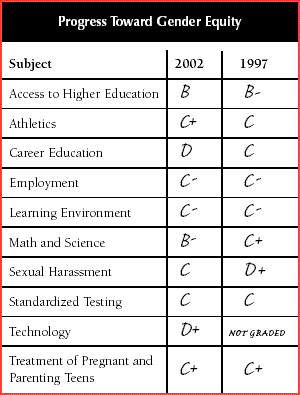|

North East Digital Village
Title IX Before & After
Too young to remember when girls weren't allowed to play full court basketball in school? (Before Title 9 women and girls were only allowed to play a six-player game in which offensive and defensive players each stayed their one half of the court and could only dribble the ball three times.)
Old enough to remember being taught posture and how to walk in "gym class"? Ever told that despite excelling in math, you really should study homemaking? Been denied entrance into shop class?
We'd love to hear your stories - whether old or young, boomer or GenX. How has Title 9 impacted your daugthers and grand-daugthers? Please email us at village@nedv.net with your memories, suggestions or references to women and sports

10 Key Areas of Title IX in 2006
- Access to Higher Education
- Athletics
- Career Education
- Education for Pregnant and Parenting Students
- Employment
- Learning Environment
- Math and Science
- Sexual Harassment
- Standardized Testing
- Technology (cite: EXercise My Rights at titleix.info)
Title IX was passed by the US Congress on June 23 1972. It is a civil rights law prohibiting discrimination in education programs and activities receiving federal funds. It was the first comprehensive federal law to prohibit sex discrimination against students and employees in these institutions.
"No person in the United States shall, on the basis of sex, be excluded from participation in, be denied the benefits of, or be subjected to discrimination under any education program or activity receiving federal financial assistance." - 20 USC 1681
Title IX was the nation's promise for ensuring that the talents of half its citizens - women - no longer would be constricted by discrimination.
Before Title IX
- Schools at all levels limited the participation of women and girls.
- Female students were not allowed to take certain courses, such as auto mechanics or criminal justice; male students could not take home economics.
- Pregnant and parenting female students frequently were forced to drop out.
- Female athletics programming generally consisted of cheerleading.
- Many colleges and professional schools had quotas limiting the number of women who could attend.
- Women seeking admission to NY State College of Agriculture in the early 1970s needed SAT scores 30 to 40 points higher than men.
- University of Virginia excluded women until 1970.
- Financial aid was withheld from women who were married, pregnant, or parenting.
- Most prestigious scholarships, such as the Rhodes Scholarship, was restricted only to men.
- Most medical and law schools limited the number of women admitted to 15 or fewer per school.
- Many colleges and universities required women to have higher test scores and better grades than male applicants to gain admission.
- With the exception of historically black colleges and universities, virtually no college offered women athletic scholarships.
- Women living on campus were not allowed to stay out past midnight.
- In college interviews, female applicants to doctoral programs often had to explain how they would combine a career with a family.
- Women faculty members were excluded from faculty clubs and encouraged to join faculty wives' clubs instead.
- Female elementary and secondary school teachers often had to leave their jobs when they married or became pregnant.
Most of the information for this section can be found in the "Report Card on Gender Equality" from the National Coalition for Women and Girls in Education. The progress reports examine the successes and failures - and the obstacles to success through the lens of 30 years of Title IX. The reports assess how far we have come in making Title IX's goal of equal opportunity a reality - and how far the United States as a nation has yet to go.
_/\_TO THE TOP
After Title IX
 |
- Sexual harassment remains pervasive in public schools. 81% of female students surveyed have experienced it.
- Sex segregation persists in career education - more than 90% of girls clustered in training programs for traditionally female fields of health, teaching, graphic arts, and office technology.
- Just 21% of all full professors at colleges and universities are women.
- For every new dollar going into athletics at the Division I and II levels, male sports receive 65 cents while female sports receive 35 cents.
- Women receive only 20% of computer science and engineering-related technology bachelor's degrees.
|
- The lower test scores of African American females, Native American females, and Latinas compared to their white and Asian peers remains a serious and deep educational divide.
- Pregnant students are steered toward separate and less academically rigorous schools.
- Title IX allows education institutions to remedy past discrimination - but the law also allows colleges/universities to exclude women from certain scholarships that have no remedial purpose, e.g., scholarships exist for male engineering Sigma Chi Fraternity members, or men who attended certain high schools.
_/\_TO THE TOP
Learn More About Title IX
_/\_TO THE TOP

This section is under constant development. Please email your suggestions to village@nedv.net.
Linking to a site is not intended to imply that either the North East Digital Village or Bizgrok, Inc endorses or guarantees the information on the linked site or any pages thereof. Linking a site to any NEDV or Bizgrok page does not imply, nor is it intended to imply endorsement by the linked party of NEDV or Bizgrok.
|
|




